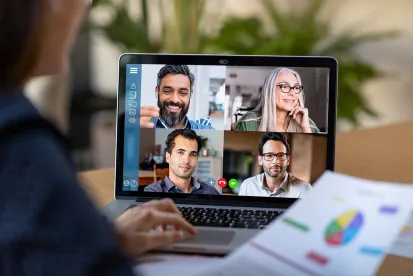In the press to return to a new normal, organizations risk forgetting important lessons learned during the past year. Convening a “lessons-learned team” to gather information about how your organization adjusted to the pandemic—what worked, what didn’t, what can be improved upon—can yield future benefits. A facilitated workshop (or series of workshops dependent upon the size of your organization) can collect information from key stakeholders at all levels of the organization that will benefit future employees.
Key areas to address may include:
Productivity
One year ago, many professionals and students were forced to cobble together new workspaces, which weren’t always the most productive. According to Logitech’s “5 Lessons Learned From Remote Working During the Pandemic” our first pain points included: background noise (44%); internet speed (42%); desk space (39%); seating and ergonomics (38%); and tools and equipment (30%).
Persistent productivity challenges have included:
-
Internet access and stability;
-
Virtual access to coworkers and critical resources; and
-
Self-management, task organization, and discipline.
If your organization plans a future workplace in which professionals will work remotely several days each week, solutions to these challenges will need to be developed.
In addition to providing resources that enhance productivity, organizations will need to become more cognizant of burnout, something that may not be readily apparent when team members are physically separated. PD teams should start gathering anecdotes from established professionals about rituals they may have used during the pandemic to separate their personal and professional lives, for example, “Unless there was a crisis, at dinnertime I walked away from my phone and computer and gave my spouse/significant other/kids 100 percent of my focus.”
These resources may also be helpful:
McKinsey & Company, “The future of work after COVID-19” (February 18, 2021)
A. Haupt, “Why a fake commute could pave the way to work-from-home balance,” Washington Post (February 23, 2021)
N. Starrs, “How to create a home office in a tiny apartment,” Washington Post (March 8, 20210
Mayo Clinic, “Office ergonomics: Your how-to guide” (April 27, 2019)
Engagement
Organizations that move forward with hybrid workplaces will need to give managers tools that will help them identify the unique talents of their direct reports and keep those reports engaged by giving them opportunities to use their talents daily.
For more than 50 years, Gallup has conducted research on employee engagement. Their key findings include:
-
Engaged employees produce better outcomes;
-
Only about one-third of U.S. workers were engaged … before the pandemic; and
-
A manager or team leader is the critical person who drives feelings of engagement.
The CliftonStrengths assessment is one tool that can provide managers, especially those who have less face-to-face interaction with team members, with critically important insights. During the past twelve months, I’ve used it with countless mid-level associates who are trying to discern their next career steps.
To read more about Gallup’s findings on employee engagement: https://www.gallup.com/
Focus on Mental Health
The pandemic pushed many organizations to focus on mental health and resilience. In the work that I’ve done with several firms during the past year, I’ve learned that junior professionals desperately want to hear from senior professionals … to hear them say, “This is tough; we know it’s tough; if we pull together, we’ll all get through it.”
Your managers and established professionals might benefit from reading “8 Ways Managers Can Support Employee’s Mental Health,” Harvard Business Review (August 7, 2020).
Among the authors’ key suggestions:
-
Be vulnerable;
-
Model healthy behaviors;
-
Build a culture of connection through regular check-ins;
-
Communicate more than you think is necessary; and
-
Practice “inclusive flexibility … proactive communication and norm-setting that helps people preserve the boundaries they need.”
If you haven’t already, create a stable of coaches, independent third parties who can help your professionals at all levels of the organization work through anxieties, frustrations, and new goals.
Video-Collaboration
During the course of the pandemic, video-collaboration has gone from being the latest and greatest way to stay in touch to become a bigger workplace distraction than emails and phone calls. Collectively, we’ve started to settle on some best practices that should be shared with summer associates and interns, including:
-
Show up on time, in person (camera on), and dressed appropriately;
-
Understand the agenda, stay focused (avoid multi-tasking) and contribute; and
-
No eating … unless, of course, it’s a scheduled coffee break, meal, or social hour.
Emphasize the importance of understanding the difference between a formal video meeting and a video check-in. In the case of the former, summer associates and interns should turn off their phones and arrange for family and roommates to stay out of the way. During more informal check-in meetings, encountering the family pet or taking a virtual tour of a workspace can help foster relationship-building.




 />i
/>i

